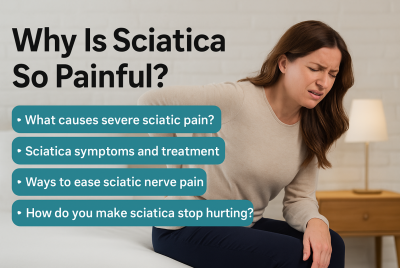Can Massage Therapy Help Sciatica Pain? Types, Techniques & Benefits
Sciatica pain can be frustrating, nagging, and sometimes downright debilitating. If you’re one of the millions dealing with pain that shoots down your lower back, buttocks, and legs, you’ve likely asked yourself: Can massage therapy help sciatica pain? The short answer: yes — in many cases, massage can significantly reduce discomfort, improve mobility, and enhance your quality of life. But not all massages are created equal, and the effectiveness depends on the type of sciatica, the technique used, and consistency.
In this complete guide, we’ll explore:
-
How massage therapy relieves sciatica
-
The best types of massage for sciatica
-
DIY massage tips at home
-
When should massage be avoided
-
How to combine massage with other treatments
-
Top FAQs about sciatica and massage
✅ How Massage Helps Sciatica Pain
Sciatica is not a condition itself but a symptom of an underlying issue that irritates or compresses the sciatic nerve, the longest nerve in the human body. It typically begins in the lower back and travels through the buttocks and down one leg.
Common causes of sciatica include:
-
Herniated or slipped discs
-
Piriformis syndrome
-
Spinal stenosis
-
Degenerative disc disease
-
Muscle imbalances or postural issues
So, where does massage come in?
Massage therapy helps by:
-
Releasing tight muscles that press on the sciatic nerve (especially the piriformis or glutes)
-
Increasing circulation, which speeds up healing and reduces inflammation
-
Reducing muscle spasms and nerve tension
-
Stimulating endorphins, your body’s natural painkillers
💡 Massage doesn’t “cure” the root cause of sciatica, but it can dramatically reduce symptoms and improve function when used consistently.
💆♂️ Best Types of Massage for Sciatica Relief
Here are the most effective massage techniques for easing sciatic nerve pain:
1. Deep Tissue Massage
Deep tissue massage targets deep layers of muscles and connective tissue. It helps:
-
Release chronic tension in the lower back and glutes
-
Break up adhesions that limit movement
-
Improve posture and mobility over time
Best for: People with muscle-based sciatica, such as from piriformis syndrome or tight glutes.
2. Trigger Point Therapy
This technique involves identifying and applying pressure to specific “knots” or trigger points that refer pain elsewhere in the body, including down the leg.
Best for: Sciatica caused by tight hip muscles (especially the piriformis).
3. Myofascial Release
This gentle technique focuses on the fascia — the connective tissue surrounding muscles. Myofascial release involves light, sustained pressure to help loosen up restricted areas.
Best for: Chronic tension, postural imbalances, or people sensitive to deep pressure.
4. Swedish Massage
Swedish massage is light, relaxing, and improves circulation. While not as targeted, it can be beneficial for stress-related muscle tightness that aggravates sciatica.
Best for: Early-stage sciatica or as a recovery session between deeper treatments.
5. Sports Massage
A combination of deep tissue and stretching techniques is often used by athletes. Sports massage improves flexibility, reduces inflammation, and promotes faster muscle recovery.
Best for: Active individuals who suffer from exercise-related sciatica flare-ups.
✅ How to Treat Sciatic Nerve with Massage
🏠 DIY Massage Tips for Sciatica at Home
You don’t always need a professional massage therapist — some basic self-massage techniques can be done right at home:
🎾 Tennis Ball or Massage Ball Release
-
Sit or lie on the floor and place a tennis ball under the glute of the affected side.
-
Gently roll until you find a tender spot.
-
Hold pressure there for 20–30 seconds.
-
Repeat 3–5 times, once or twice daily.
💥 Massage Gun (Percussion Therapy)
-
Use on low-to-medium settings.
-
Target your lower back, glutes, and hamstrings.
-
Avoid pressing directly over the spine or sciatic nerve.
🌀 Foam Rolling
Foam rolling your glutes and hamstrings can help release tight fascia and improve mobility. Start slow and increase pressure gradually.
⚠️ Always warm up the area with heat or light stretching before deep self-massage.
⚠️ When to Avoid Massage for Sciatica
Massage is generally safe, but there are situations where it could make things worse.
Avoid massage if you:
-
Have intense, shooting pain that worsens with pressure
-
Have numbness or muscle weakness in the leg
-
Experience bowel or bladder incontinence (possible sign of cauda equina syndrome — seek emergency care)
-
Recently had spinal surgery or trauma
-
Have active infections, open wounds, or skin conditions in the massage area
If you’re unsure about the cause of your sciatica, consult with a healthcare provider before starting massage therapy.
🧘 Best Practices: Combining Massage with Other Treatments
To maximize your results, combine massage therapy with other natural treatments:
-
Stretching: Especially hamstrings, piriformis, and hip flexors
-
Heat Therapy: Use heating pads before the massage to loosen muscles
-
Cold Therapy: Apply ice afterward to reduce inflammation if soreness occurs
-
Anti-Inflammatory Diet: Reduce processed foods, sugar, and trans fats
-
Posture Correction: Use ergonomic chairs and avoid prolonged sitting
-
Exercise: Walking, gentle yoga, and core strengthening can reduce pressure on the sciatic nerve
Remember: Consistency is key.
Massage is most effective when done regularly and supported by a well-rounded self-care routine.
❓ FAQs About Can Massage Therapy Help Sciatica Pain
1. How often should I get a massage for sciatica pain?
For moderate to severe pain, 1–2 times per week for the first few weeks can help. Once pain improves, once a month may be enough for maintenance.
2. Can massage make sciatica worse?
Yes, if it’s too aggressive or performed incorrectly. Always communicate with your therapist and stop if pain worsens after a session.
3. Is a massage gun good for sciatica relief?
Massage guns can be helpful for muscle tension around the sciatic nerve. Use on a low setting and avoid pressing directly on bones or nerves.
4. Where should you massage for sciatica?
Focus on the glutes, piriformis muscle, lower back, and hamstrings — these areas commonly affect sciatic nerve compression.
5. Can massage cure sciatica permanently?
Massage can relieve symptoms and support healing, but it doesn’t cure the root causes, like herniated discs. It’s most effective when combined with stretching, posture work, and medical guidance.
✅ Final Thoughts
So, does massage therapy help sciatica pain? For many people, the answer is a resounding yes. While massage won’t cure structural issues like herniated discs, it can relieve pain, relax tight muscles, and help you move better, all without medication.
Whether you choose professional therapy or at-home techniques, the key is to be consistent, gentle, and to pair massage with other supportive treatments.
Disclaimer
Please note that this article should not replace professional medical advice. Consult a healthcare professional for an accurate diagnosis and tailored treatment plan.

👉 Next Steps:




